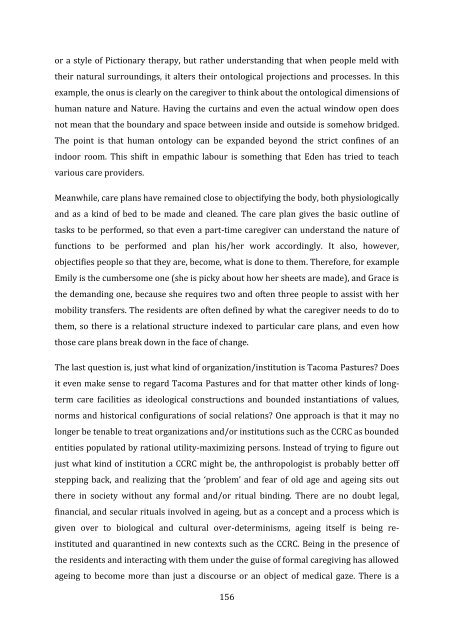Philip Y. Kao PhD thesis - Research@StAndrews:FullText
Philip Y. Kao PhD thesis - Research@StAndrews:FullText
Philip Y. Kao PhD thesis - Research@StAndrews:FullText
Create successful ePaper yourself
Turn your PDF publications into a flip-book with our unique Google optimized e-Paper software.
or a style of Pictionary therapy, but rather understanding that when people meld with<br />
their natural surroundings, it alters their ontological projections and processes. In this<br />
example, the onus is clearly on the caregiver to think about the ontological dimensions of<br />
human nature and Nature. Having the curtains and even the actual window open does<br />
not mean that the boundary and space between inside and outside is somehow bridged.<br />
The point is that human ontology can be expanded beyond the strict confines of an<br />
indoor room. This shift in empathic labour is something that Eden has tried to teach<br />
various care providers.<br />
Meanwhile, care plans have remained close to objectifying the body, both physiologically<br />
and as a kind of bed to be made and cleaned. The care plan gives the basic outline of<br />
tasks to be performed, so that even a part-time caregiver can understand the nature of<br />
functions to be performed and plan his/her work accordingly. It also, however,<br />
objectifies people so that they are, become, what is done to them. Therefore, for example<br />
Emily is the cumbersome one (she is picky about how her sheets are made), and Grace is<br />
the demanding one, because she requires two and often three people to assist with her<br />
mobility transfers. The residents are often defined by what the caregiver needs to do to<br />
them, so there is a relational structure indexed to particular care plans, and even how<br />
those care plans break down in the face of change.<br />
The last question is, just what kind of organization/institution is Tacoma Pastures? Does<br />
it even make sense to regard Tacoma Pastures and for that matter other kinds of longterm<br />
care facilities as ideological constructions and bounded instantiations of values,<br />
norms and historical configurations of social relations? One approach is that it may no<br />
longer be tenable to treat organizations and/or institutions such as the CCRC as bounded<br />
entities populated by rational utility-maximizing persons. Instead of trying to figure out<br />
just what kind of institution a CCRC might be, the anthropologist is probably better off<br />
stepping back, and realizing that the ‘problem’ and fear of old age and ageing sits out<br />
there in society without any formal and/or ritual binding. There are no doubt legal,<br />
financial, and secular rituals involved in ageing, but as a concept and a process which is<br />
given over to biological and cultural over-determinisms, ageing itself is being reinstituted<br />
and quarantined in new contexts such as the CCRC. Being in the presence of<br />
the residents and interacting with them under the guise of formal caregiving has allowed<br />
ageing to become more than just a discourse or an object of medical gaze. There is a<br />
156
















